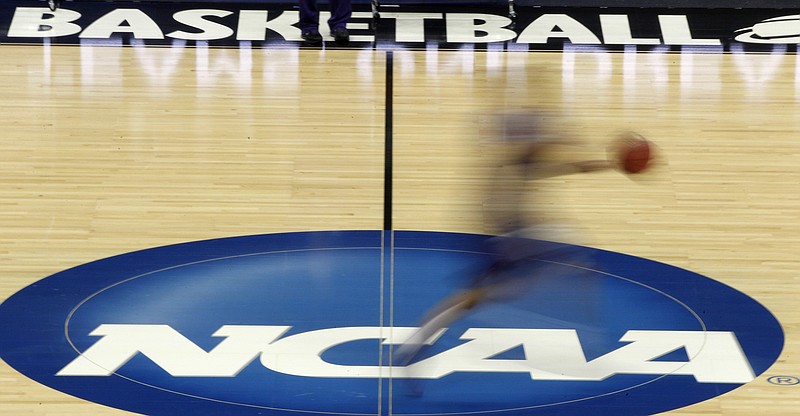Upon closer inspection, there's only one way for this 2018 NCAA men's basketball tournament to end - only one conclusion that's guaranteed to turn the off-court stench of the regular season into one slimy moment come April 2 in San Antonio.
That fitting finish is this: NCAA president Mark Emmert gritting his teeth as he hands the national championship trophy to Arizona coach Sean Miller and the most outstanding player award to Wildcats center Deandre Ayton.
After all, what could better sum up the monstrous mess that all of college hoops finds itself in today than Emperor Emmert being forced to give his organization's most prized trophy to the coach who's been accused of striking a $100,000 deal with an agent to procure the services of Ayton, who's all but certain to be the next one-and-done mercenary to become an overall No. 1 pick in June's NBA draft?
That Miller is still coaching and Ayton is still playing is a shock to some, though perhaps only a slightly bigger shock than the ridiculously talented Cactus Cats receiving a paltry No. 4 seed in the South Regional after winning both the Pac-12 regular-season and tournament titles.
Perhaps that No. 4 seed was some kind of unofficial punishment for the yet unproven FBI charges aimed at Miller and Ayton, who both continue to vehemently deny the accusations.
Or perhaps it was another perceived shot at Kentucky coach John Calipari, who routinely decries his team's tourney draw but may be onto something here given that the Wildcats are the fifth seed in the South and would face 'Zona in the round of 32 if UK survives dangerous Davidson and Arizona befuddles Buffalo.
For starters, UK has a better Rating Percentage Index (10) than any of the No. 4 seeds: Arizona (13), Auburn (15), Gonzaga (21) and Wichita State (16). Second, it has a far superior strength of schedule, what with Arizona coming in at No. 68, Auburn No. 55, Gonzaga No. 151 and Wichita No. 33 to UK's No. 6.
Beyond that, Kentucky is hot, having won seven of its last eight games, including five against the NCAA field, though not quite as hot as Gonzaga, which has won 14 straight.
As for Arizona, the Cactus Cats have won eight of their last nine, own 14 wins over the top 100 (UK has 16) and won their three Pac-12 tourney games by an average of 14 points.
So maybe Kentucky-Arizona regarding the seed line - 4 or 5 - is a push. But this isn't: use of the S-curve, which is a system that is supposed to place the best No. 1 (in this case, South top seed Virginia) against the worst No. 2, the best No. 3, the worst No. 4 and the best No. 5, etc.
By that standard, given the above data, there was no way that Arizona was the worst No. 4 to UK's top No. 5. By that standard, 'Zona should have been the top No. 4 and Auburn, by virtue of its 4-5 record down the stretch, should have been the weakest No. 4.
Here's where it gets a bit questionable, however. According to the NCAA's David Worlock: "The committee used the S-curve on the first two lines after having repeated trouble with competitive balance on the top four lines. (The committee) returned to using geography and conference affiliation for lines three and four."
And herein lies the problem. There's no consistency. No transparency. No uniformity.
You just can't use the S-curve for some slots and not for others. Beyond that, consider that the latest NCAA RPI rankings have the four No. 1 seeds (Virginia, Villanova, Xavier and Kansas) in the top four RPI slots. They have three of the No. 2 seeds (North Carolina, Cincinnati and Duke) in the next four sports, Tennessee standing eighth.
Given that Purdue (9) winds up on the No. 2 line and Tennessee is the top No. 3, everything is pretty much status quo at that point.
But UK is a No. 10, which should have possibly placed it on the No. 3 line and certainly no lower than the No. 4 line, given how closely the committee seemed to follow the RPI for spots one through nine. And Arizona, with an RPI of 13, certainly deserved to be slotted as the top No. 4.
Calipari's rants about being placed in the "play-in game" or being sent to "Anchorage" probably don't help UK's cause much.
Beyond that, Arizona's Miller certainly was smart to take the high road Monday when he said of his Cactus Cats' seed: "I think for us you can't make too much of the seed or the place you're going. You have to play well. It can be the perfect set-up, but if you don't play really well there's so much parity in the tournament that you'll end up losing."
Kentucky easily could lose to hot-shooting Davidson, which averaged 10 made 3-pointers a game. Arizona might fall to Buffalo.
And what happened in the South Region seeding wasn't half as bad as placing Kansas, Duke and Michigan State in the same Midwest Region. Or handing a spot to reeling Oklahoma over solid St. Mary's or Oklahoma State, which beat OU twice, Kansas twice and West Virginia once.
Nor is any of this half as serious as the black cloud hanging over the entire sport due to the FBI probe into schools and agents buying players. The bungled brackets are a paper cut. The pay-for-play scandal threatens to behead the entire sport.
But applying the S-curve and RPI in some cases but not in others is also why a lot of folks view the selection committee as representing a couple of different words that start with S: snakes and snake oil salesmen.
Contact Mark Wiedmer at mwiedmer@timesfreepress.com.
